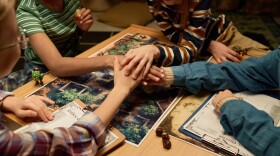The 2017 Milwaukee Film Festival kicks off this week. Its centerpiece film takes us into a story familiar to many Milwaukeeans. In 2014 Dontre Hamilton was killed by a police officer in downtown Milwaukee.
The Blood is at the Doorstep, from director Erik Ljung, follows Hamilton’s family as they grieve, heal, and fight for change in their city.
Race and Ethnicity Reporter Aisha Turner spoke with Ljung about the process of making the film, and how it’s challenged and changed him.
Red Arrow Park
Bells ring out on a Saturday morning in downtown Milwaukee…
City buses drop passengers at the corner of Water and Kilbourn…
People walk their dogs through the area of Red Arrow Park that becomes an ice rink in the winter...
“I played hockey growing up and I would go ice skating and play hockey on the rink when it was closed - don't tell anybody,” says Erik Ljung half jokingly.

Red Arrow Park is now solemn ground. “Now if I come, here it's for a purpose,” he continues. “Either I'm filming coming here or I'm coming to look at the memorial. I don't come here to hang out anymore.”
On April 30, 2014 Milwaukee police officer Christopher Manney responded to a call that a man -- Dontre Hamilton -- was sleeping in the park, outside of Starbucks. There was an altercation. Manney shot Hamilton 14 times.
Erik Ljung spent the last three years following Dontre Hamilton’s family. His film brings viewers into their world. At the beginning of the film, Dontre’s older brother - Nate Hamilton - goes through an evidence bag from the scene of the shooting.
He pulls out the blue blanket Donre was sleeping on. “So this is basically the last thing he laid on in Red Arrow Park,” Nate says softly.
He scrolls through Dontre’s cell phone. “If you look on the 29th, the day before [he died], I called him six times. And I talked to Dontre April 30th and talking to him that day he sounded fine. He asked me how I was doing.”
He finds a message from their mom. “I think they said the shooting happened at 3:30? At 3:23 my mom called Dontre. So this is basically when he was being killed. My momma called him because she ain’t heard from him.”
Becoming a Filmmaker
The Blood is at the Doorstep premiered almost seven months ago at South By Southwest. And has been screened in New York and DC since then. But the Milwaukee Film Festival is its homecoming. The festival will be the first time the film is screened publicly in the city.
“This is what we’ve been looking forward to this whole time,” Erik says. And with excitement, comes anxiety. “When we show the film elsewhere people aren’t really familiar with the story. And this is a very personal story for Milwaukee so it holds a different significance. We're excited to finally bring [the film] home to Milwaukee.”
"This is what we have been looking forward to this whole time. We are excited to finally bring [the film] home to Milwaukee."
This is Erik’s first feature-length documentary. He was born and raised in California -- home to a pretty famous film scene. “I always thought growing up you had to be rich or a starving artist to be a filmmaker.” So other than a few skater videos he made as a kid, he couldn’t have foreseen a career in production.
Erik hopped around a lot in college. He started at UC-Santa Barbara and transferred four times over six years. “It was hard for me to choose one thing I wanted to do. I took an anthropology class and I was like ‘I love anthropology! This is great!’” He said the same about art history, business, sociology, and psychology. “Everything was interesting to me.” He settled on graphic design -- creative, but practical.
In 2008 he moved to Milwaukee, following a girlfriend who was headed here for her PhD. They broke up, but he stuck around anyway.

His first job was kiddy corner from Red Arrow Park. He did graphic design for the Pabst Theater. And he added photo and video editing to his skill set.
Then a few friends were making a documentary following the Milwaukee bands Juniper Tar and Strand of Oaks on an East Coast tour. Erik took a week off of work to join them. That’s when he knew he had to become a filmmaker. “It wasn’t so much about the bands, it was more about the experience of being on the road and the people you meet along the way.” He was proud of the work. “That film gave me the confidence to be like ‘I could do this!’”
He quit the Pabst and lined up freelance news jobs, corporate video projects, even wedding gigs. The low cost of living in Milwaukee made it easier to make ends meet as a filmmaker here versus New York or LA.

One piece he worked on was a 2014 package for Vice News about Corey Stingley.
In 2012 customers at a convenience store in West Allis suspected Stingley of shoplifting. They held him down. The 16-year boy old died from a lack of oxygen.
In early 2014 Milwaukee County DA John Chisholm decided that no criminal charges would be filed. That was fresh in Erik’s mind when he learned about the Dontre Hamilton shooting. “I was thinking about Corey Stingley and the history of things that have gone wrong in this city and wanting to know more.”
Documenting the Hamilton Family
Erik was originally interested in the Hamilton case from a mental health perspective. Dontre had schizophrenia. “I have a cousin I grew up with that has paranoid schizophrenia and is homeless in my hometown,” he says. “I was reading a lot of comments early on about this family. I think a lot of people cast judgement on the Hamilton family early on. So I was interested in knowing more about the perspective of the Hamilton family and the challenges the faced.”

That spring he juggled his freelance assignments and kept tabs on the case -- from a distance.
“I didn’t want to impose myself. They were already going through so much -- they had the media in their face, they had to learn the legal system, and they were also grieving. “So it was intimidating for me to approach them.”
He didn’t approach them until the summer of 2014 when the Hamilton family started putting themselves out in public and holding rallies at Red Arrow Park.
In August of 2014 Michael Brown was killed in Ferguson, Missouri. And, Erik says that high profile police killing changed the dynamic in Milwaukee. “There was a national awareness of what was going on and more and more people wanted to show solidarity.”
Through his camera, Erik watched the protests for police accountability grow.
"It was amazing to see [the Hamiltons] go from a feeling of defeat to taking control of the narrative and say we are gonna force people to give us answers."
He gathered 500 hours of video tape. He captured tense protests in City Hall… And quiet moments of anticipation as the family waited for an answer on whether the District Attorney would charge the officer who killed Dontre.
The officer wasn’t charged.
Even so, the family looked for other signs of victory. For instance, they lobbied the city to require better mental health training for police officers. Nate Hamilton founded the Coalition for Justice. His mom, Maria Hamilton, started Mothers for Justice United.
Erik remembers: “It was amazing to see them go from a feeling of defeat to taking control of the narrative and say ‘we’re gonna force people to give us answers.’ It was amazing watching them go from apolitical to organizing themselves and pushing for change on their own.”
“A lot of times when stuff like this happens,” he says, “it’s activists taking the reigns and supporting the family. But in this instance it really was the family taking the lead and having activists fall behind.”

The Responsibility of Storytelling
It's been a hard three years for Erik. The weight of the story combined with the long Wisconsin winters made it difficult to leave the house sometimes. “Making this film was by far the most difficult thing I’ve ever done in my life. It’s a very emotional, dark case. I went through bouts of depression.”
He thought about quitting -- he’d produced a short documentary for the New York Times about the case. He thought maybe that was enough.

But he felt a responsibility to keep the project growing.
“I think this film is bigger than me you know? I think through the course of the filmmaking I realized I might be too tired to film this one thing this one day but nobody’s gonna care that I didn’t sleep one night or that I missed this thing because I went on a date or something like that… I cut out a lot of things in life over the last three years and made a lot of sacrifices to make this because I realized that people are only gonna judge the film and maybe the family by what’s put on the screen. There really weren’t any excuses for me.”
With this film, Erik’s had an opportunity to go deep and tell the kind of full story he wants to see more of. He’s worked in breaking news stories before and “always felt gross afterwards.” “You’re swooping in, getting some shots of a family crying then you’re on to the next story. I prefer doing this longer form journalism endeavour because you have more time with your subjects and you’re not only showing sad things, you’re showing growth and showing them heal. I think that’s important, too.”
Erik closes the film with scenes of the family dancing and laughing as the credits roll -- images of healing he’s captured over the last three years.
A song plays, it’s a dedication to Dontre -- written by his brothers.
...I still dream about you daily. Tears keep streaming going crazy. I just need you here. I want you here. I’m screaming one love...
The Blood is on the Doorstep will have three screenings during the Milwaukee Film Festival. The first one on October 6th has already sold out.

Do you have a question about race in Milwaukee? Submit it below.
_
Support for Race & Ethnicity Reporting provided by the Dohmen Company.





